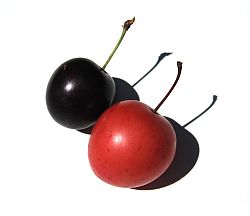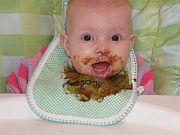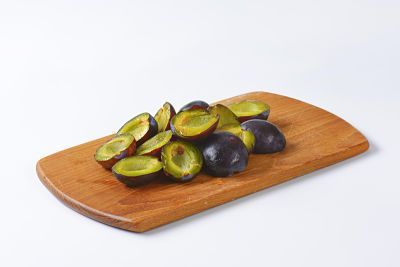Homemade Plum Baby Food Recipes
Updated: Sept 11, 2023
Learn how to make the perfect plum baby food for your little one with our delicious recipes, tips and nutritional information!
When can my baby eat plums?
Plums may be introduced to your baby from 6 months of age (with your doctor’s consent) or earlier if recommended by your pediatrician… although we actually recommend NOT introducing them as a very first food.
Why?
Well, plums have a mildly laxative effect on the body and may loosen your baby’s stools.
For this reason, plums are RECOMMENDED for curing constipation, but should be AVOIDED if your baby is suffering from diarrhea.
Handy tip…
The laxative effect of plums comes from the isatin, which is contained in the skin.
Therefore, this effect can be reduced significantly by peeling plums before use.
Find out more about whether or not to peel fruits and vegetables for baby
Are plums good for my baby?

They certainly are!
Plums are a good source of calcium, vitamin A (in the form of beta-carotene), vitamin B2, vitamin C, vitamin E and fibre.
They contain powerful anti-oxidants, which help protect the body against serious diseases like cancer.
Plums are also credited with boosting the body’s ability to absorb iron – probably because of their high vitamin C content.
And, in later life, plums help lower the body’s cholesterol levels, thanks to the soluble fibre (pectin) they contain.
Plum facts
- With over 2,000 varieties, there are more types of plum than any other stone fruit.
- There are over 100 varieties of plum in the United States alone!
- Plums are known as ‘drupes’. Drupes are fruits that have their seeds surrounded by a hard, stone pit.
- Plums are related to nectarines, peaches… and almonds!
- Plums come in an array of different colours, with skins in varying hues of blue, black, red, green and yellow.
The flesh may be orange, pink, green or yellow. - Dried plums are known as prunes – click here to learn more about making baby food with prunes.
- Plums range in flavour from very sweet to quite tart!
The tartness comes from the skin and some babies much prefer peeled plums for this reason!
Which are the best types of plums for baby food?
Well, this partly depends on your baby’s preferences, of course, but our little ones have always enjoyed Santa Rosa, Burbank and Victoria plums, which seem to be perfectly sweet and juicy!
Choosing and storing the fruit for your plum baby food recipes
- Look for plums that yield a little bit (not too much) when you squeeze them gently. Another good sign is if the tip of the plum is slightly soft.
- Choose richly coloured plums with no bruises or holes in the skin, but don’t worry if the skin is covered with a white ‘bloom’.
In fact, this is preferable, as it indicates that the plums haven’t been handled too much. - Avoid plums that are ‘rock’ hard. They were probably picked too early and will never have a good flavour or texture.
- If your plums are a little under-ripe, then leave them at room temperature to ripen them.
Plums ripen quite quickly, so make sure you keep an eye on them! - Store ripe plums in the refrigerator and use them within a few days.
If you have lots of plums, you can freeze them before preparing them, although it’s recommended that you remove the pits first. - Store prepared plum baby food in the refrigerator for up to 48 hours – if you have prepared a large quantity in advance, then store it in the freezer (you’ll find freezing tips on our Baby Food Storage and How to Freeze Baby Food pages).
Readers' Pics

Mmm! I love this stuff!
My baby loves this stuff! She is very into (literally) her ‘perfect plums’!
Jen – Charleston, SC, USA
Preparing plum baby food
It is important that you use fully ripe plums when preparing your plum baby food recipes. There are two reasons for this…
- ripe plums have a sweet taste and better texture
- studies have shown that fully mature fruit contains more anti-oxidants than under-ripe fruit
When you introduce plums to your baby for the first time, it is a good idea to cook them.
Once your baby is enjoying cooked plums, then you might like to try pureeing raw plums (but only if they are fully ripe and sweet).
Find out more about whether or not to cook fruits and vegetables for your baby
If you DO choose to puree raw plums for your baby, bring them to room temperature first – they will taste better and will be more juicy.
How to easily remove the pit from a plum
- Cut the plum in half lengthwise.
- Twist the two halves in opposite directions until they come apart.
- Take out the pit!
Are fresh plums unavailable in your area?
How to remove the skin from a plum
- Boil water and pour it into a small bowl. Fill a second bowl with cold water and ice.
- Drop the plum into the boiling water and immerse it for 30 seconds (this is known as blanching).
- Remove the plum from the hot water (carefully) and drop it into the cold water – this will instantly stop the blanching process.
- Slide off the skin.
Alternatively…
You may cook plums with the skin on, by cutting an ‘x’ into the skin and placing the plum ‘x’ side down in around an inch of water.
We like to cook plums with both the skin and pit intact, as this seems to preserve their natural sweetness.
Handy tip…
For a super yummy puree, simmer the plums in apple juice instead of water.
Delicious!
To make a very simple plum puree…
Either simmer the whole plum (as described above) or peeled chunks of plum in around an inch of water until tender (4-8 mins).
Drain (reserving the cooking water) and puree the plum by pushing through a sieve or using a food processor.
Add back a little cooking water if necessary, to create the perfect texture for your baby.
Could my baby be allergic to plums?
Allergy to plums is rare – nevertheless, there is always the possibility that any individual can be allergic to ANY food.
When introducing plums to your baby, remember to follow the four day rule to help you identify any potential digestive problems or allergic reactions.
There are two types of allergy to plums…
Individuals with an allergy to birch pollen may also be allergic to plums, because there is a protein in plums that is similar to a protein in birch pollen.
The symptoms, which usually appear within 5-15 minutes of the plums being eaten, include inflammation or itching of the mouth and/or throat (known as oral allergy syndrome).
Cooking destroys this allergen, so people with birch pollen allergy can usually eat cooked plums.
The other type of plum allergy is often associated with an allergy to peach and triggers more severe symptoms, including
- oral allergy syndrom
- eurticaria (hives)
- vomiting
- abdominal pain
This allergen is NOT destroyed by cooking – so even cooked plums are unsafe – and the reaction is often worse if the skin is eaten along with the flesh.
Plum baby food ideas
Plums are great served alone, mixed with other fruits… and even used in savoury dishes!
Here are some tasty plum baby food ideas…
- Mix pureed plum with mashed banana
- Combine pureed plum and pear – the sweetness of the pear counteracts any tartness in the plum
- Stir a tablespoon of sweet, pureed plum into homemade yogurt
- Add a little pizzaz to baby rice cereal by mixing in pureed – or finely chopped – plum
- Stir finely chopped plum into cooked brown rice to add a delicious, fruity element!
Plum baby food recipes
Baked Plums With Cinnamon (6 months+)
4 plums
apple juice
cinnamon
- Preheat the oven to 400 deg F (200 deg C).
- Halve the plums, remove the pits and place them in a small, oven-proof dish.
- Add a few tablespoons of apple juice and sprinkle the cinnamon over the top.
- Cover, then bake in the oven for around 20-25 mins, until the plums are tender (check halfway through the cooking time to make sure there is enough cooking liquid).
- Cool, remove the skins (if desired), then puree or mash.
Pork and Plum with Potato Gnocchi (7 months+)
8 oz (1 cup) pork loin
4 oz (1/2 cup) ripe plums, skin and stone removed
3 fl oz (3/8 cup) apple juice
little pinch of dried sage
For the potato gnocchi…
12 oz (1 1/2 cups) potato, peeled and sliced
1 oz (1/8 cup) flour
- First, pour the apple juice into a small saucepan and simmer the plums until tender.
- Drain the plums – reserving the juice – then puree them, adding a little of the juice to create a smooth sauce.
- Meanwhile, cook the pork. To avoid large lumps, shred the meat with a fork, then simmer it in a little homemade (or salt free) chicken broth or water until cooked.
- Drain the pork and stir it into the plum sauce, along with the sage.
To prepare the gnocchi…
- Simmer the potatoes in water until fork tender.
- Drain, then puree the potatoes in a food processor whilst still warm.
- Add the flour gradually, until the mixture is smooth and a little sticky. The amount of flour you’ll need varies, depending on the type of potato used.
- Roll the potato mixture out on a floured surface and form it into a ‘sausage’, about 1/2 inch thick.
- Cut the ‘sausage’ into 1 inch lengths, then shape each piece by pressing it across the prongs of a fork.
- Roll it as you do so, which will give you the distinctive gnocchi shape.
- Bring a saucepan of water to the boil. Drop in the gnocchi – when they are done, they will rise to the surface (about 3-4 mins).
- Serve with the pork and plum sauce, along with steamed veggies (carrots suit this dish perfectly)!
Creamy Plum Popsicles (7 months+)
4 oz (1/2 cup) fresh plums, peeled, pitted and chopped
3 oz (1/3 cup) pureed peach
5 oz (2/3 cup) homemade yogurt
drop vanilla essence
- Combine all the ingredients in a bowl.
- Spoon into popsicle (lolly) moulds and freeze unitl firm.
- If your baby is too young to handle popsicles, simply crush the frozen mixture in a bowl and serve with a spoon.
Roasted Plums with Yogurt (6 months+)
4 plums
vanilla pod
1 tsp unsalted butter
pure maple syrup
homemade yogurt
- Preheat the oven to 375 deg F (190 deg C).
- Halve and pit the plums and place them in a small baking dish, with the cut side up.
- In each plum half, place a tiny piece of the vanilla pod, a tiny bit of butter and a little drop of maple syrup.
- Place in the oven and roast, uncovered, for 20-30 mins, until tender.
- Remove the skins (if desired) then serve mashed or pureed, topped with the natural yogurt.


